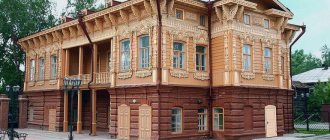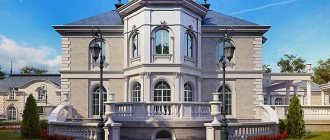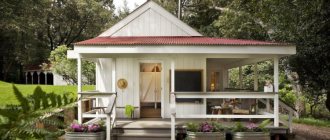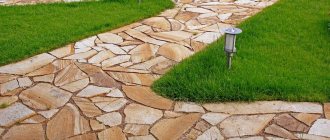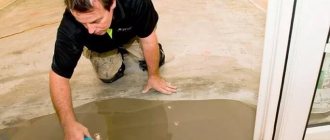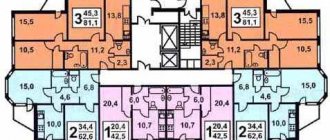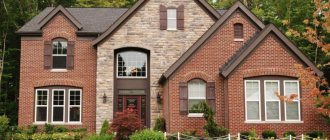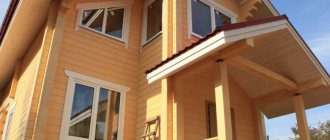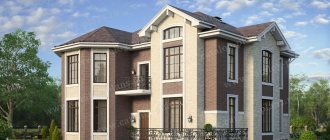The most striking manifestations of Russian architecture in terms of country buildings of the 18th and 19th centuries are the Russian estate and merchant house. And if the first version of buildings is used quite widely, then designs of houses in the merchant style are not so popular.
| Project No. 10-40 | Project No. 11-72 | Project No. 10-46 |
Design Features
Historically, merchant-style houses were a square or rectangular building 1-2 stories high, but modern designs allow taller buildings to be built. Other characteristic features of merchant private mansions are:
- Combination of materials used in construction. The lower floor was usually built of brick, and the upper floor was made of wood.
- The use of a simple (compared to the multi-level roof of a Russian estate) two- or four-slope roof.
- Use of natural materials in interiors.
- Availability of light on the top floor. It was a well-lit room, somewhat reminiscent of a modern attic.
- Hemming the eaves overhangs. A mandatory element, the finishing of which is carried out carefully and from high-quality materials.
- The use of various decorative elements on the facade (carved frames and shutters, stair railings, porches or balconies, etc.), although their number is much less than during the construction of an estate. This shows the main difference between them - the Russian merchant style shows the wealth of the owner of the building, without being as flashy and sticking it out as in the case of a Russian estate.
The ability to stay within the confines of style is the main and very characteristic feature of the best representatives of the domestic merchant class, who had enormous wealth, but did not boast of their own wealth.
What varieties are known?
It has one important feature - the presence of three directions. Some of them will look ridiculous even in a typical home with this atmosphere. That is why when working with a room, take into account the nuances of each of them. Each has its own characteristics in the Russian style in the interior, which are worth considering in more detail.
Russian hut
It is quite difficult to decorate an apartment in this direction; the overall appearance will look ridiculous, so it is ideal for country houses. It doesn’t matter at all whether you live in this house permanently or come to take a break from the noisy city. Basic principle: minimum technology – maximum natural materials. A house of this type should be a continuation of nature.
Russian style in the interior cannot do without wood; here it is the basis of everything. Boards with an aged effect will look great. Instead of plastic windows, install wooden frames with swing shutters. If you absolutely do not want to give up plastic windows, style them as wood.
Wood is the basis of Russian style
It was customary to welcome guests in the hut and eat food in the upper room. In the modern world, it serves simultaneously for eating and relaxing. This explains the fact that the upper room has always been the brightest and most spacious room. In this place there should be a large stove, which will find a place even in a modern design, a table and a corner with icons. The stove is used immediately for cooking food, storing basic utensils and beautifully decorating the kitchen and dining room. It looks great in the style of a Russian mansion.
It is worth paying special attention to the bedroom and the main element – the bed. It must be decorated with duvets, many small pillows and a huge amount of textiles. In the Russian style, they used to actively sew from scraps; nowadays this technique is called patchwork. Now this technology is used in Russia in many other areas and by residents from other countries. This makes shopping for a colorful blanket easier.
It is advisable to decorate the bed with pillows and bedspreads
The upper room must have a stove or fireplace
Russian style in the interior looks very beautiful and harmonious
People's Tower
This Russian style in the interior is worth using if you love luxury and wealth. Patterns of the brightest colors, chests with all the riches and other pieces of furniture characteristic of the nobility and in the general style of Russian Rococo - these elements must be placed in your home if you decide to decorate it in the “terem” direction. The nobles lived in their own world, which is why they were characterized by special style features with their own decorative elements.
This direction is closest to modern types of design. Walls in the Russian style are decorated with various types of fabrics or some types of wallpaper. The floors are covered with parquet and covered with beautiful and luxurious carpets. If rough furniture is used in a country house, here you can freely place armchairs and sofas in the house.
Important! If you are installing armchairs, the upholstery must be chosen only from high-quality fabric in the style of a Russian mansion. It's worth spending a little to buy quality fabric, but it looks very beautiful and complements the atmosphere of the room.
For good lighting, buy a large crystal chandelier. Please note: it is necessary to buy large chandeliers; in those days they were considered an indicator of a certain status of the owner of the house. In this case, metal elements are imitated into gold. It is recommended to decorate the rooms with brocade.
Icons and towels were often hung on the walls
In Russian style you need to use only natural materials
A la russe
This Russian style in the interior most accurately reflects national motifs. This explains the incredible popularity of “a la russe” in other countries of the world. When arranging your home, use nesting dolls, balalaikas, samovars and other attributes loved by tourists. One of the most controversial trends: some consider it vulgar to decorate a room this way, others happily use folk motifs.
Important! Use only those things that have practical value, otherwise your home will turn into Plyushkin’s house.
In the Russian style, many people use the ornament separately or only as accessories. Even in the modern world, there must be painted dishes in the house, from which it will be pleasant to eat yourself and treat guests. At that time, it was popular to decorate porcelain dinner sets with paintings in floral motifs. This tradition has not gone away over time, so you can use this technique both on holidays and in everyday life.
This Russian style in the interior most accurately reflects national motifs
Use only things that have value
In the Russian style, many people use the ornament separately or only as accessories.
A crazy bright and effective element in the interior of this trend can certainly be called lace. The first lace sparkled incredibly, because it was woven from gold and silver threads. Nowadays it is quite difficult to find such lace. If you still want to purchase this particular option, buy Vologda lace. Don't be afraid to use napkins, tablecloths and curtains to serve as luxurious accessories in your home.
Before you start decorating, think carefully about the design.
Lace was often used in Russian style
Examples of merchant style house designs
A striking example of a modern building of the style in question is project No. 10-40 . The ground floor is made of classic brick, and above there is a three-story log house with mandatory lighting not only on the 3rd, but also on the 2nd floor. The high porch with richly decorated posts and railings is complemented by a second-floor balcony in the same style.
The building has a large number of eaves overhangs, thanks to the lanterns in the lights and the canopy over the porch. All of them are finished carefully and with high quality, which gives the building a stylish and expensive look.
Another example of such a cottage is project No. 11-72 . It is not combined, since the walls are made of wood. However, thanks to the finishing of the ground floor with decorative stone, the building is fully consistent with the merchant style. Other characteristic features:
- simple gable roof with hemmed cornice;
- high porch;
- a balcony made in the same style;
- obligatory light on the second floor.
The simplest version of a merchant mansion is represented by project No. 10-46 . It consists of two log houses placed side by side. The basement is finished with artificial stone, the cornices are hemmed, and the rooms on the second floor are illuminated thanks to the presence of three large windows. All these are features inherent in merchant private buildings.
In Murom, as in any other merchant city, civil buildings of the 18th-19th centuries have been preserved, mainly the estates and mansions of Murom merchants and merchant women.
Unfortunately, many ancient buildings were destroyed, because after large fires at the turn of the 18th-19th centuries. the city was completely rebuilt. KRASNOARMEYSKAYA STREET
From the Ermakov estate you can walk along Uspenskaya Street (modern Krasnoarmeyskaya Street). The street is small, it is closed on both sides by church buildings: on the one hand, the Annunciation and Trinity Monasteries, on the other, the Assumption (St. George) Church, built in 1792 at the expense of the merchant Dmitry Ivanovich Likhonin. This is one of the few streets of modern Murom, which to some extent has preserved the mood and appearance of the district town of the beginning. XX century There are one-story houses with a rustic look “with three windows”, and two-story houses with a wooden top and a stone bottom. Such half-stone houses were very convenient both for living and for running your own business or craft. Nearby is the Shtapsky ravine (or Uspensky - after the name of the temple). Rich stone mansions stand out among the ordinary buildings on Krasnoarmeyskaya Street (formerly Uspenskaya). One of them (25 Krasnoarmeyskaya St.) belonged to the hereditary honorary citizen Fyodor Vasilyevich Suzdaltsev. This beautiful two-story house with columns is still the decoration of the entire street. Fyodor Vasilyevich bought it in 1846. There are practically no houses of this type left in Murom. The owner of the house F.V. Suzdaltsev was engaged in the linen and bread trade and had a linen establishment. In 1848 he was elected burgomaster to the magistrate, and then city mayor (from 1857 to 1859). The position of mayor was held by his father Vasily Timofeevich and older brother Ivan.
St. Krasnoarmeyskaya, 25. House of merchant Zvorykin, XIX century.
St. Krasnoarmeyskaya, 27. House of merchant Zvorykin, XIX century. (in municipal ownership).
PERVOMAISKAYA STREET
Modern Pervomayskaya Street in Murom stretches from north to south for more than two kilometers. It originates from the ancient administrative center of the city - the Kremlin over the Oka. Parallel to it is located one of the central artels of the city - st. Lenin. In the 17th century, after the city had long ago lost its significance as a military outpost and the Kremlin had fallen into disrepair, the Nikolo-Zaryadskaya Church was built on its northwestern side. From her the street was called Nikolskaya. Many centuries passed over the street, but the winds of time changed its appearance little. And the easier it is to mentally imagine the events of long ago, which the old street witnessed. Some hundred years ago, on Pervomaiskaya only certain blocks were once covered with cobblestones. On the road and on the sidewalks, not only passers-by, but also horses and carts got stuck in the mud. But for several decades now, the roadway has been covered with asphalt. Over time, the appearance changed. In the south, some tiny wooden houses fell to the onslaught of builders. A deep ravine stretched from the river to the middle of the street. Postal routes from Moscow to Nizhny Novgorod and Siberia ran along its bottom. Along Nikolskaya they went out onto Moskovskaya and out of the city towards Moscow. In October 1790, A.N. was taken to Siberian exile along this street. Radishcheva. Dishonored, sick, shackled, he saw life around him that confirmed he was right. In 1826, along this same mournful road, the wives of the Decembrists, exiled to Siberia, went to hard labor to join their husbands. The princely carriages carried E.I. Trubetskoy, M.N. Volkonskaya, A.G. Muravyov. Along the same road, 23-year-old A.I. went into exile, separated from his family and fiancée. Herzen. In several places, the street blocks recede deeper into the area. Here, at the intersection with Komsomolskaya Street, since those ancient times, when one of the water booths, built along with the water supply system in the Middle Ages, stood here. XIX century, a wasteland was formed. In the 60s In the 20th century they tried to turn it into a youth park, but it didn’t work out. This place changed and became one of the remarkable corners of the city after they decided to install here a bust of twice Hero of Socialist Labor Rostislav Apollosovich Belyakov.
Zworykin House
Address: st. Pervomaiskaya, 4 The Zvorykin House is the main building of the Murom Historical and Art Museum. Three-story mansion with a mezzanine from the 19th century. - one of the largest and most beautiful houses in the city. A world-famous scientist, “the father of television,” Vladimir Kozmich Zvorykin (1889-1982) was born and spent his youth here. There is a memorial plaque installed in the Zvorykin mansion in Murom, and a monument is located in front of his home. For a long time, the Zvorykins’ house housed exhibitions on the history and culture of Murom. The building is currently closed due to upcoming reconstruction.
House of the Zvorykins
See Monuments of Murom.
Former City Council building
Address: st. Pervomaiskaya, 6 The Art Gallery is another remarkable building. It is located next to the Zvorykins’ house and occupies a two-story building from the early 19th century. (1815), which previously belonged to the City Duma. The exhibition of the art gallery presents the best art collections of the museum. Based on the collection of Russian and Western European art of the 17th - 19th centuries. lies the collection of Counts Uvarov from their Karacharov estate, the Red Mountain Estate (Kirova St.). In the gallery, visitors will be able to see family portraits, collectible furniture, porcelain, as well as paintings by Russian and Western European masters, located in Karacharovo.
Art Gallery
Gladkov's house. XIX century st. Pervomaiskaya, 10
Alexander Konstantinovich Gladkov
House of the Likhonin merchants, 1816 st. Pervomaiskaya, 14
House of merchant Voshchinin, 1846 st. Pervomaiskaya, 22
The building of the trading shop of the merchant Myazdrikov. XX century st. Pervomaiskaya, 5
Wojtas employee store building, 20th century. st. Pervomaiskaya, 11
House of the merchant Kiselev, XVII-XIX centuries. st. Pervomaiskaya, 23
In the middle of the 19th century, the house belonged to the merchant Ivan Vasilyevich Kiselev (1830-1909). At that time his family was engaged in the grain trade. On January 19, 1909, a venerable old man died - Hereditary Honorary Citizen Ivan Vasilyevich Kiselev, who served as ktitor of the Exaltation of the Cross, mountains. Murom, churches for 30 years. For his zealous service and for his concern for the splendor of his parish church, he was most mercifully awarded the title of Hereditary Honorary Citizen and awarded a silver medal to be worn around his neck on a Stanislav ribbon. I.V. was known in the city as a true Christian, a strict follower of the commandments of God and the statutes of St. churches. An outstanding feature of his character was his submission to the will of God and the humility with which he endured the sorrows that befell him; and there were quite a few of them in his life; suffice it to say that he buried three sons and two daughters - at a flourishing age and humbly, like the righteous Job, endured such losses. After the death of Ivan Vasilyevich, the widow Maria Dmitrievna Kiseleva had to rent out rooms in the house in order to recoup the maintenance costs. In 1914, by decision of the city duma, a private men's gymnasium for Lesyuk, a former mathematics teacher, was opened in this building. The progymnasium differed from others in that education did not cost money. Here the boys learned to read, write and learned several obligatory prayers. This is where the history of the house begins, as a place called to teach and raise children. He did not lose his calling even after the ban on private schools in 1921. House of Pioneers. This is what this building was called after the closure of the gymnasium until recently. And this status was assigned to him until the reorganization on October 1, 1990. The House of Pioneers hosted an art studio, aircraft modeling, modeling, “Young Travelers”, “Young Fishers” and drama clubs. Since 1952, cutting and sewing circles began to operate at the House of Pioneers, in which 150 girls studied. Over the 20 years since the House of Pioneers began its work, the number of clubs has tripled, and the number of children has increased almost fivefold. In the 90s, this building was the home of technical creativity. However, due to the need for reconstruction, on March 25, 2008, the Council of People's Deputies decided to sell the house into private ownership at auction. The reconstruction plan was drawn up by the Department and, since this is an architectural monument, was agreed upon with the Vladimir Inspectorate for Objects of General Cultural Heritage. The owner's original plan was to use the second floor as living quarters and equip the first floor as a cafe. All that remains of the House of Pioneers is the name. Thanks to the “efforts” of the owner, the house was left without windows, roof and load-bearing walls.
House of the tradesman Serebrennikov of the 20th century. st. Pervomaiskaya, 31
Tent of the merchant Myazdrikov, 19th century. st. Pervomaiskaya, 37
House of merchant Kiselev, 1860 st. Pervomaiskaya, 39
House of the Shvedov-Karatygins
On the former Blagoveshchenskaya Street (now Timiryazev Street, 3) stands one of the most interesting houses in the city. Abandoned to the mercy of fate and forgotten by everyone, it makes a depressing impression, gaping with the empty eye sockets of broken windows. Old-timers call it “Karatygin’s House”. However, in local history literature, the former mansion of the Karatygin merchants is mentioned only with the proclamation of Soviet power. Few people know that in 1875 the Murom Real School was located there. For a long time nothing was known about the fate of the house and its owners. Archival research has shown that the Karatygin House has a very interesting history. Initially, the house belonged to the merchant of the first guild, Grigory Aleksandrovich Shvedov. G.A. Shvedov was born in 1804. First he lived in Vladimir, and then in Orenburg. Having accumulated capital, in 1831 he joined the merchants of the second guild of Simbirsk. Four years later G.A. Shvedov became a merchant of the first guild. In 1835, together with his family, the merchant moved to Stavropol, and two years later - to Murom. On May 17, 1837, becoming a Murom merchant, G.A. Shvedov acquires a plot of land in the 16th block on Blagoveshchenskaya Street and builds a beautiful house. Below, in the ravine, there was a linen factory, purchased on September 29, 1836. Three years later, Shvedov’s factory was considered one of the best in the city. About its owner, local historian A.A. Titov wrote enthusiastically: “Merchant G.A. Shvedov, having again set up the factory in the best possible way, promises good success in this manufacturing industry based on his capital and knowledge of chemistry and mechanics.” It is also known that G.A. Shvedov was engaged in beet processing and sugar production. On May 13, 1843, the Senate elevated G.A. Shvedov and his family to hereditary honorary citizenship. The family of the merchant of the first guild was large: his wife Elena Ivanovna and five children - Peter (b. 1829), Mikhail (b. 1832), Elena (b. 1834), Nikolai (b. 1837), Anna (b. 1841) and Ivan ( born 1844). After the death of their father, the Shvedov brothers were unable to independently conduct trading operations. Gradually they went bankrupt. On December 7, 1862, the Shvedov family estate passed to the merchant of the third guild, Maxim Afanasyevich Karatygin. See Karatygin Ivan Maksimovich
House of the Shvedov-Karatygins
House of the Zhuravlevs
St. Vorovskogo, 2. Zhuravlev House. 1970–1975
For several years it stood homeless - with broken windows and boarded up doors, abandoned to the mercy of fate.
TRADE RANKS
Shopping arcades Square 1100th anniversary of Murom, 2
The shopping arcades in Murom were built in 1816. This is a fairly simple, classical structure, but not without the majesty that the arches and massive columns of the Doric order give it. Under the rows there were deep cellars with vaulted ceilings where grain was stored. The quality of construction of the shopping arcades is such that they have been able to withstand almost 200 years with virtually no repairs. The colorful shopping arcades appear repeatedly in various films. But being scenery in a movie is by no means their only or main function. There is still trade here, and behind the rows there is a large city market. The following facilities are located in this building: Central Library, Barin Cafe.
MOSKOVSKAYA STREET
Moskovskaya Street is the central street of Murom. Formed in the beginning. XIX century after the approval of the new city plan.
House of Merchants Golubev Exhibition Center St. Moskovskaya, 13
The exhibition center is located in a two-story mansion of the Golubev merchants of the 19th century, closing the first block of Moskovskaya Street. Temporary exhibitions are held in the Center's halls, and in the two large upper halls there is an exhibition dedicated to the history of the city. Here you can see both household items and sacred objects - icons, church utensils. See Historical and Art Museum of Murom.
St. Moskovskaya, 11
St. Moskovskaya, 9
St. Moskovskaya, 7
St. Moskovskaya, 5
St. Moskovskaya, 4
House of the Zvorykin merchants. House of the bourgeois Konstantinova (XIX century) St. Moskovskaya, 33
Old police building. “In the year 1743, the magistrate of the city of Murom established the first police chief office in the Vladimir province, which marked the beginning of the public order service.”
Around this place, mass riots began on June 30, 1961. Nowadays it is the building of the Murom District Internal Affairs Directorate.
House of merchant I.V. Korshchikova
Address: st. Moskovskaya, 26 In 1886, the newspaper Sovremennye Izvestia, commenting on the progress of the investigation, wrote that the Murom merchant I.V. Korshchikov had a very dark reputation. The former beggar of the village of Karacharovo suddenly began to become rich. There was talk about selling counterfeit money. Back in the early 1880s. he bought two stone houses in Murom - on Rozhdestvenskaya Street (not preserved) and on Moskovskaya (No. 26). In 1885, yesterday's peasant became a merchant. It is known that initially I.V. Korshchikov was engaged in wine farming (one of the most profitable businesses in Russia). In the 1890s. merchant I.V. Korshchikov and his son Ivan owned a stone shop in Gostiny Dvor. Having accumulated capital in the wine business, by the end of the 90s. The Korshchikovs engaged in an equally profitable grain trade. After the death of the head of the family (he died in 1905), Mikhail Korshchikov began to manage trading affairs. In 1911 he owned nine bread shops.
City of Murom
Murom Park of Culture and Leisure named after. IN AND. Lenin. Park named after Yu.A. Gagarin. Youth Embankment Park in the city of Murom. Prokurorova Square in microdistrict. Verbovsky. Square of the 1100th anniversary of Murom Ermakov Square Monuments of the mountains. Murom Museums of the city of Murom. Emelyanov's House
